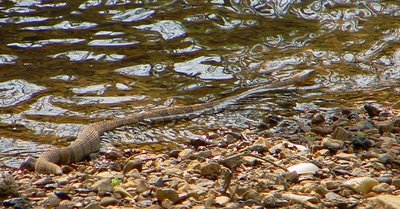
Yesterday, I went on my first group ride. Yes, there were only three of us and we're all friends. But those who were reading this blog last summer understand what an accomplishment this is for me.

Ever since I began to ride a roadbike, I've been whining about wanting to learn how to ride in a group... yet refusing to go on group rides. Yes, it was paradoxical. But you see, I wanted to learn the
skillsof riding in a group, while at the same time being afraid of it - convinced that I would perish in a high speed crash, images of the most gruesome bicycle race pile-ups flashing through my mind. I toyed with the idea of joining the women's training rides offered by a local cycling team, but ultimately the entire summer passed and I did not do it - opting for solitary rides and occasional rides with the Co-Habitant instead. I had to be coaxed into joining yesterday's ride, and I did try to back out as usual... but in the end something just clicked in my head and I went. And I'm
very glad. Yes, I know you told me so!

My cycling partners were the Co-Habitant on his nearly-finished
Surly Cross-Check (notice the fenders!) and our neighbour Somervillain on his vintage 650B conversion.

I was on my
Rivendell Sam Hillborne. How happy he was to be out amidst the cherry blossoms!

Though we were riding different bikes, the aesthetic was amusingly similar. We all had candy-coloured frames with fat tires, cantilever brakes, aluminumfenders, leather saddles, classic bar wrap, and even twined water bottles. All three of us were also wearing wool. We looked like a team of eccentric bicycle obsessionists. The plan was to go on a roughly 40 mile loop - starting on the Minuteman Trail, then going through the hilly parts of Lexington, and arriving in Concord, MA - where we would stop before returning along a similar route.

Any nervousness I had about the ride dissipated as soon as the three of us set off in city traffic on the way to the Minuteman Trail. I expected this to be stressful - keeping pace with the others while paying attention to cars and negotiating treacherous intersections - but instead it was easy. Easier than cycling in traffic alone
andeasier than cycling in traffic with just the Co-Habitant.I still need to think this through in order to understand why, but possibly because three cyclists really do constitute a group in the eyes of motorists and are thus given more space. Maybe. Whatever the reason, it was great.

For the first part of our ride, we went in an unchanging single file procession - with the Co-Habitant first, Somervillain second, and me last. We cycled fairly closely behind one another, which I did not find problematic. It took me some time to get used to the rhythm with which Somervillain started from a stop, and to time my own starts the same way so that I wouldn't run into him. But otherwise, it was all very intuitive. I did not have trouble pacing myself to maintain the same speed consistently. And I also liked it that they hand-signaled every move they would make on the road. When we cycle alone, the Co-Habitant and I don't do this - which sometimes results in miscommunication.

We went along the Minuteman Trail at 14-16mph, then headed for the hills in Lexington. We've had an especially long winter and rainy spring this year, and I had not done major hills like this since last Fall. I was physically unprepared for them. I also forgot how steep and long this one particular hill was. We began climbing it, and almost immediately I was spinning in a low gear and my speed dropped to 7mph. I just couldn't do any better. It was at this point that we dispersed, so that the stronger riders would not lose momentum. Somervillain took off uphill and the Co-Habitant followed him at a slower pace, but still faster than me. I eventually made it, but the climb was such a huge shock to my system that even the downhill decent that followed made me unable to catch up with them. As soon as the distance between us decreased, came another uphill and I would lose them again. While I found this frustrating, I also appreciated having a true sense of the differences in our abilities. And I certainly preferred them going ahead to slowing down for me - that would have made me feel excruciatingly self-conscious. We cycled over a series of hills in a similar style - the distance between us decreasing on the descent, then increasing again on the ascent - until finally the elevation changes lessened and we were able to cycle in a single file again. I did not have trouble keeping up on flats and mild hills, so that was a relief. The day had been beautiful and sunny up until then, but now it started to rain, which was a relief as well. The raindrops cooled me down.

We stopped in the Concord town center to have lunch and coffee. The sun came out again by then, and the small town looked ridiculously picturesque - blue skies, green grass and cherry blossoms everywhere.

We filled up our water bottles.

And Somervillain showed us his clever iphone-charging system.

The socket is built into the light mount and derives its power from the dynamo hub. He made it himself. I don't own an iphone, but still want this on my bike!

At some point in the course of the ride, the Co-Habitant's brakes suddenly became stronger, solving his brake dilema. Looks like they just needed to wear in.

My writing skills are not strong enough to make the canti-comparison conversation that followed sound interesting, but I'll show you Somervillain's
Mafac brakes.

And my
Tektrobrakes. After a thorough examination of my bike, wemay now have a diagnosis for my complaint about the drivetrain fussiness: bent derailleur hanger, possibly. So I will have to take care of that.

After the town center, we cycled a bit further and stopped by Walden Pond.

Even with lots of people there on a Sunday, it is still such a quiet, meditative place.

We chose a slightly less hilly route home, and the return part of our loop was more casual. We switched places in line frequently, and at times cycled in a cluster instead of a procession - all of which I was fine with. I got a sudden burst of energy on the way back and did not feel tired.

It is fair to conclude that my first group ride was a success. I enjoyed cycling in a procession at a controlled speed, and I did not have problems riding in close proximity to the others. I guess my sense of incompetence in this respect was exaggerated. The losing them on hills aspect I will have to work on, but I think it is to be expected given the differences in physical strength between us.
I looked up the schedule for the women's training rides this summer, and the first one of the season is this Tuesday - tomorrow! Before I lose my nerve, I think I need to just force myself to show up. Will make my best effort - now off to shop for a certain required accessory!


 Belgian (and Dutch) architecture is based on Gothic Renaissance architectural character. Belgian architecture though has more Baroque influence than the Dutch and one can see it clearly on its facade details.
Belgian (and Dutch) architecture is based on Gothic Renaissance architectural character. Belgian architecture though has more Baroque influence than the Dutch and one can see it clearly on its facade details. Photo courtesy ofDave Searle. Ally Swinton high on the Colton/Mac
Photo courtesy ofDave Searle. Ally Swinton high on the Colton/Mac Until you end up loooking like this!
Until you end up loooking like this!





 Our little trip took us to one of the most beautiful sites we've ever laid eyes on: our granddaughter. My mom will probably tell you that the picture above looks like my baby pictures. That's not why I think she is beautiful though. She just is!
Our little trip took us to one of the most beautiful sites we've ever laid eyes on: our granddaughter. My mom will probably tell you that the picture above looks like my baby pictures. That's not why I think she is beautiful though. She just is! Makes you want to sniff her newborn baby head, doesn't it? How is it that even baby slobber is cute?
Makes you want to sniff her newborn baby head, doesn't it? How is it that even baby slobber is cute? I'm a little smitten with her. Ah, who am I kidding...I'm completely head over heels in love with her!!!!!
I'm a little smitten with her. Ah, who am I kidding...I'm completely head over heels in love with her!!!!! She is so smart and funny already. She makes a different face every ten seconds which cracks us up.
She is so smart and funny already. She makes a different face every ten seconds which cracks us up. Papa thinks she is the greatest thing too!
Papa thinks she is the greatest thing too! My best birthday ever was when I had Aric (happy Birthday number one son) but this ranked right up there. She's a keeper to be sure!
My best birthday ever was when I had Aric (happy Birthday number one son) but this ranked right up there. She's a keeper to be sure!